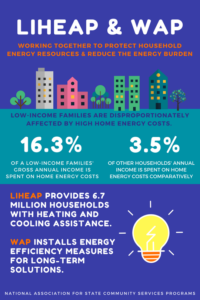Written By: Jaimee Kidd, NASCSP Intern
 The Low Income Home Energy Assistance Program (LIHEAP) provides critical support to low-income families working to ensure their own energy security and affordability. This August marks another LIHEAP Action Month where we recognize the incredible impact of this program and recommit to strengthening its role in supporting the health and safety of American families.
The Low Income Home Energy Assistance Program (LIHEAP) provides critical support to low-income families working to ensure their own energy security and affordability. This August marks another LIHEAP Action Month where we recognize the incredible impact of this program and recommit to strengthening its role in supporting the health and safety of American families.
For decades, LIHEAP has worked alongside the Weatherization Assistance Program (WAP) to reduce the energy burden for low-income, vulnerable families. Managed by the Department of Energy, WAP focuses on installing energy conservation measures in low-income homes, such as insulation, duct sealing, efficient light bulbs, furnace repair or replacement, and more. According to an evaluation by Oak Ridge National Laboratory, these services save a low-income family at least $283 a year and reduce heating bills by 30% on average.
LIHEAP, overseen by the Department of Health and Human Services Office of Community Services, provides direct assistance to help households cover a portion of their energy costs and keep their utilities running. According the HHS LIHEAP Clearinghouse, this program provides heating and cooling assistance to more than 6 million households every year.
Home energy costs disproportionately impact families with low incomes who, on average, pay 16.3% of their total family income towards home energy costs compared to 3.5% for higher income families. The Home Energy Affordability Gap Project has long been studying these burdens by evaluating the gaps between an affordable home energy bill, set at 6% of gross household income, and an actual home energy bill. The project provides specific data on energy burden at the county and congressional district level.
The geographic location of a family also plays a part in this burden. According to a recent study, from the American Council for an Energy Efficient Economy, rural households have a higher energy cost as a percentage of their income when compared to metropolitan households. Rural low-income households, which make up 40% of the rural population, carry three times the energy burden of their higher-income neighbors.
In these highly burdened communities, both LIHEAP and WAP work hand in hand to have maximum impact. LIHEAP focuses on addressing critical needs to avoid energy shut-offs which have serious health and safety consequences. WAP in turn provides a long-term investment by shouldering the cost of energy efficiency improvements that low-income households are often unable to afford. Together, the programs protect families, reduce energy burdens, and increase efficiency, health, and safety.
This month in particular, we celebrate and recognize the importance of the critical role LIHEAP plays in the lives of millions of families in need. A toolkit provided by the National Energy and Utility Affordability Coalition helps outline the many ways to spread the message about this celebration throughout the month of August and well after. More detailed information about LIHEAP can also be found on the National Energy Assistance Directors Association’s website.





